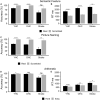Investigating Language and Domain-General Processing in Neurotypicals and Individuals With Aphasia - A Functional Near-Infrared Spectroscopy Pilot Study
- PMID: 34602997
- PMCID: PMC8484538
- DOI: 10.3389/fnhum.2021.728151
Investigating Language and Domain-General Processing in Neurotypicals and Individuals With Aphasia - A Functional Near-Infrared Spectroscopy Pilot Study
Abstract
Brain reorganization patterns associated with language recovery after stroke have long been debated. Studying mechanisms of spontaneous and treatment-induced language recovery in post-stroke aphasia requires a network-based approach given the potential for recruitment of perilesional left hemisphere language regions, homologous right hemisphere language regions, and/or spared bilateral domain-general regions. Recent hardware, software, and methodological advances in functional near-infrared spectroscopy (fNIRS) make it well-suited to examine this question. fNIRS is cost-effective with minimal contraindications, making it a robust option to monitor treatment-related brain activation changes over time. Establishing clear activation patterns in neurotypical adults during language and domain-general cognitive processes via fNIRS is an important first step. Some fNIRS studies have investigated key language processes in healthy adults, yet findings are challenging to interpret in the context of methodological limitations. This pilot study used fNIRS to capture brain activation during language and domain-general processing in neurotypicals and individuals with aphasia. These findings will serve as a reference when interpreting treatment-related changes in brain activation patterns in post-stroke aphasia in the future. Twenty-four young healthy controls, seventeen older healthy controls, and six individuals with left hemisphere stroke-induced aphasia completed two language tasks (i.e., semantic feature, picture naming) and one domain-general cognitive task (i.e., arithmetic) twice during fNIRS. The probe covered bilateral frontal, parietal, and temporal lobes and included short-separation detectors for scalp signal nuisance regression. Younger and older healthy controls activated core language regions during semantic feature processing (e.g., left inferior frontal gyrus pars opercularis) and lexical retrieval (e.g., left inferior frontal gyrus pars triangularis) and domain-general regions (e.g., bilateral middle frontal gyri) during hard versus easy arithmetic as expected. Consistent with theories of post-stroke language recovery, individuals with aphasia activated areas outside the traditional networks: left superior frontal gyrus and left supramarginal gyrus during semantic feature judgment; left superior frontal gyrus and right precentral gyrus during picture naming; and left inferior frontal gyrus pars opercularis during arithmetic processing. The preliminary findings in the stroke group highlight the utility of using fNIRS to study language and domain-general processing in aphasia.
Keywords: aphasia; cognition; healthy subjects; language; near infrared-spectroscopy; stroke.
Copyright © 2021 Gilmore, Yücel, Li, Boas and Kiran.
Conflict of interest statement
The authors declare that the research was conducted in the absence of any commercial or financial relationships that could be construed as a potential conflict of interest.
Figures












Similar articles
-
The relationships between the amount of spared tissue, percent signal change, and accuracy in semantic processing in aphasia.Neuropsychologia. 2016 Apr;84:113-26. doi: 10.1016/j.neuropsychologia.2015.10.019. Epub 2016 Jan 13. Neuropsychologia. 2016. PMID: 26775192 Free PMC article.
-
Therapy-induced brain reorganization patterns in aphasia.Brain. 2015 Apr;138(Pt 4):1097-112. doi: 10.1093/brain/awv022. Epub 2015 Feb 15. Brain. 2015. PMID: 25688082
-
Language networks in aphasia and health: A 1000 participant activation likelihood estimation meta-analysis.Neuroimage. 2021 Jun;233:117960. doi: 10.1016/j.neuroimage.2021.117960. Epub 2021 Mar 17. Neuroimage. 2021. PMID: 33744459
-
Neural Resources Supporting Language Production vs. Comprehension in Chronic Post-stroke Aphasia: A Meta-Analysis Using Activation Likelihood Estimates.Front Hum Neurosci. 2021 Oct 25;15:680933. doi: 10.3389/fnhum.2021.680933. eCollection 2021. Front Hum Neurosci. 2021. PMID: 34759804 Free PMC article.
-
Imaging effects related to language improvements by rTMS.Restor Neurol Neurosci. 2016 Apr 11;34(4):531-6. doi: 10.3233/RNN-150631. Restor Neurol Neurosci. 2016. PMID: 27080074 Review.
Cited by
-
Concurrent Structural and Functional Patterns in Patients With Amnestic Mild Cognitive Impairment.Front Aging Neurosci. 2022 May 17;14:838161. doi: 10.3389/fnagi.2022.838161. eCollection 2022. Front Aging Neurosci. 2022. PMID: 35663572 Free PMC article.
-
Understanding, facilitating and predicting aphasia recovery after rehabilitation.Int J Speech Lang Pathol. 2022 Jun;24(3):248-259. doi: 10.1080/17549507.2022.2075036. Epub 2022 May 23. Int J Speech Lang Pathol. 2022. PMID: 35603543 Free PMC article. Review.
-
fNIRS Studies of Individuals with Speech and Language Impairment Underreport Sociodemographics: A Systematic Review.Neuropsychol Rev. 2024 Sep;34(3):860-881. doi: 10.1007/s11065-023-09618-y. Epub 2023 Sep 25. Neuropsychol Rev. 2024. PMID: 37747652
-
Language reorganization patterns in global aphasia-evidence from fNIRS.Front Neurol. 2023 Jan 6;13:1025384. doi: 10.3389/fneur.2022.1025384. eCollection 2022. Front Neurol. 2023. PMID: 36686505 Free PMC article.
-
Resting-State Connectivity in Acute and Subacute Poststroke Aphasia: A Functional Near-Infrared Spectroscopy Pilot Study.Brain Connect. 2023 Oct;13(8):441-452. doi: 10.1089/brain.2022.0065. Epub 2023 May 15. Brain Connect. 2023. PMID: 37097208 Free PMC article.
References
Grants and funding
LinkOut - more resources
Full Text Sources
Miscellaneous

